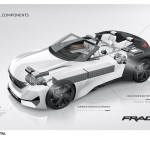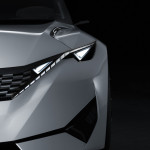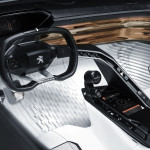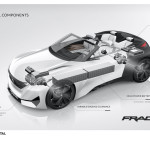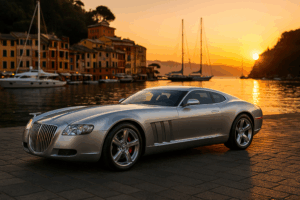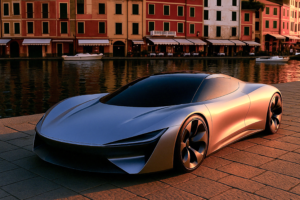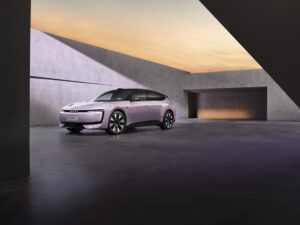FRACTAL amplifies the PEUGEOT i-Cockpit® with sound
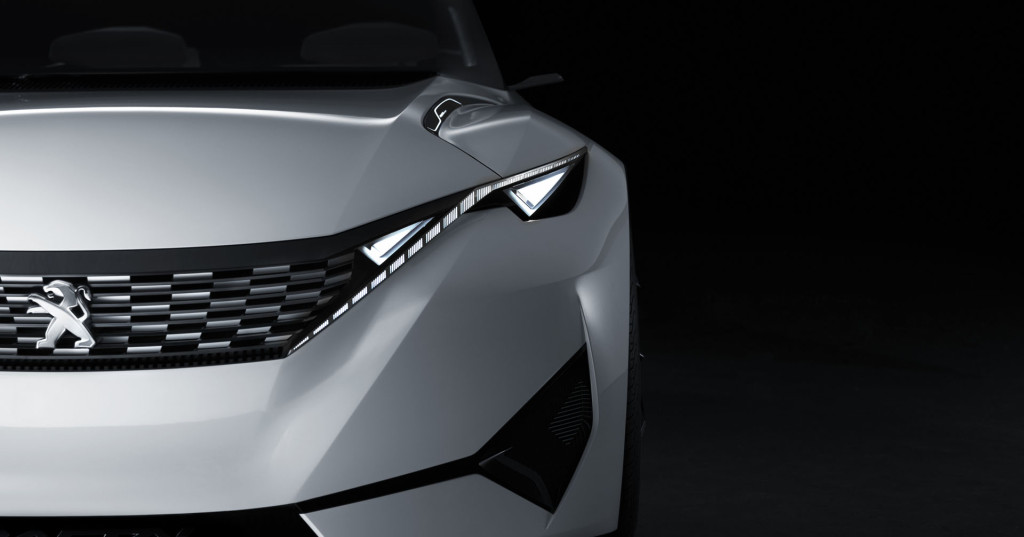
 First unveiled on the SR1 concept car in 2010, the PEUGEOT i-Cockpit® has already won over more than 1.8 million customers since making its market debut on the 208 in 2012. With its innovative ergonomics, the cockpit provides instinctive driving and enhances the experience behind the wheel.
First unveiled on the SR1 concept car in 2010, the PEUGEOT i-Cockpit® has already won over more than 1.8 million customers since making its market debut on the 208 in 2012. With its innovative ergonomics, the cockpit provides instinctive driving and enhances the experience behind the wheel.
PEUGEOT FRACTAL is an electric urban coupé revealing a prospective design of the PEUGEOT i-Cockpit® that explores another of the senses: following on from visual; embodied by the head-up display, and touch; with the compact steering wheel and touchscreen, PEUGEOT FRACTAL showcases unprecedented attention to acoustics in automotive design. The result is a level of auditory perception that further enriches the driving experience.
PEUGEOT FRACTAL also features a sound signature created by sound designer Amon Tobin, which plays when the driver opens the doors using the smartwatch remote system. What follows is a unique electric coupé driving experience offering a wealth of sensory exploration.
https://youtu.be/a5SwDl2SpU8
PEUGEOT FRACTAL is an electric urban coupé revealing a prospective design for the PEUGEOT i Cockpit® that explores the sense of hearing in addition to sight and touch. It makes driving even more instinctive, creating an unparalleled on-board experience.
StelLab is a PSA Peugeot Citroën research unit that has designed an innovative ‘9.1.2’ sound system combining a high-quality 9.1 set-up featuring tactile bass systems built into the back of each seat.
9.1.2 makes driving more instinctive by enriching information through the use of acoustics. This additional feature of the PEUGEOT i-Cockpit® is characterised by the ‘spatialisation’ and ‘dynamisation’ of sound.
PEUGEOT FRACTAL has an interior and exterior identity developed for the first time in partnership with sound designer Amon Tobin. In the city, the car is in sync with its environment.
PEUGEOT FRACTAL’s head-up display features a high-definition holographic screen and a 45-degree polycarbonate strip that delivers additional information and creates an impression of depth. This allows the driver to customise the way information is shown.
PEUGEOT FRACTAL is an ideas incubator that explores new design and manufacturing processes. 3D-printed parts represent more than 80% of the interior trim surface. The anechoic materials were made through generative design – a process used to achieve the perfect component.
The 40 kW/h lithium-ion battery powers the electric motors on the front and rear axles to provide a total output of 150 kW/204hp and combined-cycle autonomy of up to 450km.
Variable ground clearance allows the vehicle to adapt to different types of terrain. The 7cm clearance for motorway driving improves aerodynamics to range and boost battery life. This can be increased to 11cm in urban environments, allowing the car to take speed humps and car park entrances in its stride.
PEUGEOT FRACTAL: an electric urban coupé
PEUGEOT FRACTAL negotiates city streets with ease, always in sync with its environment. The car is extremely compact, at 3.81m long and 1.77m wide, allowing it to weave through heavy traffic. The 19 inch Tall&Narrow wheels are positioned at either end of the car, with an overhang of just 0.52m front and back to improve manoeuvrability.
PEUGEOT FRACTAL strikes a natural balance and features an electric drive train enabling a new architecture. All components are positioned with efficiency in mind. The lithium-ion battery is housed in the central tunnel, which lowers the centre of gravity and improves weight distribution. It powers two electric motors, each delivering 75kW/102hp, fitted to the front and rear axles. The drive train enhances the aerodynamics of the car, an improvement reflected in the smaller intakes at the front, with less air needed for cooling.
The PEUGEOT FRACTAL’s styling also embodies the car’s ease in an urban environment, which is reflected in the dynamic lines that flow along the length of the smooth body. The Coupe Franche, a straight line dual paint finish, further enhances the sense of vitality with a sharp shift from intense white to matt black at the door hinges. The upper body features a removable roof to turn the coupé into a cabriolet.
An LED strip above the vent at the rear shows the battery charge status via an equalizer-type display. These LEDs also act as rear lights when PEUGEOT FRACTAL is moving. The light signature in the front starts below the grille and flows over the headlamps. It also includes scrolling indicators.
PEUGEOT FRACTAL is perfectly at home in the city. The already-low noise levels achieved by the electric drive system are further improved by the Tall&Narrow tyres, with their narrow tread. To achieve the highest standards in acoustic performance, the wheels feature dihedral components to attenuate aerodynamic noise. Based on anechoic chambers, these additions reduce the intensity of sound waves, and therefore their noise levels, by causing them to bounce from one surface to another. This type of design is impossible to produce using conventional methods and was achieved through 3D printing.
PEUGEOT FRACTAL has a unique sound signature to keep it in sync with other road users, especially pedestrians and cyclists: any pedestrians about to step out into the road without looking will be alerted to the PEUGEOT FRACTAL’s presence.
The concept also makes everyday life easier for the vehicle owner through the use of a Samsung Gear S smartwatch, which provides continuous information on the status of the battery, charging time, interior temperature and vehicle location. The watch gives the driver one-touch access to open the doors and customize interior features such as the air conditioning and sound system.
The PEUGEOT i-Cockpit® offers an unparalleled experience combining instinctive ergonomics with an unprecedented ambience. The choice of materials is inspired by auditoriums and recording studios: black oak decorates the instrument panel, door panels and bucket seats; copper trim reminiscent of audio connections runs through the interior, with 3D-printed anechoic motifs enhancing acoustic comfort. A 3D textile mesh covers the seats and is offset by white leather trim.
To ensure constant control, the driver’s seat provides kinaesthetic feedback based on the PEUGEOT FRACTAL’s handling. The intuitive, compact steering wheel features a touchpad integrated into each of its two spokes. These thumb-controlled sensors control a range of PEUGEOT FRACTAL functions and equipment.
The head-up display provides a holographic eye-level digital readout with a 45-degree polycarbonate strip delivering additional information. Drivers can customise the 12.3-inch HD digital display to suit individual preferences. The tilted polycarbonate strip gives added depth by showing information on a 7.7-inch AMOLED screen.
There are also toggle switches within easy reach on the arches on either side of the steering wheel. The right hand arch also houses the controls to activate the electric drive system. The 7.7-inch AMOLED touchscreen built into the centre console can be used to control all PEUGEOT FRACTAL functions. Passengers in the rear also have a panel allowing them to adjust their immediate surroundings.
PEUGEOT FRACTAL is an ideas incubator that explores the use of 3D printing to create shapes that cannot be obtained through any other process. The resulting parts and components represent more than 80% of the interior surfaces and offer a combination of new styling and real functionality. The touchpad wires run through the spokes of the compact steering wheel.
The anechoic surfaces cover more than 15 square metres of the cabin interior and were produced by generative design. The computing power of today’s machines makes it possible to explore all variations of shapes and structures for a given part. Generative design creates efficient shapes and develops the perfect part in each case through the use of algorithms. PEUGEOT FRACTAL uses just the right amount of material to ensure acoustic efficiency.
This prospective PEUGEOT i-Cockpit® design gives hearing its rightful place alongside sight and touch, since people rely on all three of these senses to negotiate their immediate environment. PEUGEOT FRACTAL features an innovative 9.1.2 sound system and acoustic design.
Drivers need to process an increasing amount of information within their vehicle, which demands more and more attention. The acoustic ergonomics enhance interaction with the PEUGEOT i-Cockpit® and makes it easier to keep eyes on the road. The spatialisation of sound sources allows the driver to absorb and understand information more effectively and easily.
Vincent Roussarie, specialist in New Acoustic Services, PSA Research & Development Division
StelLab is a PSA PEUGEOT CITROËN research unit that has designed an innovative 9.1.2 sound system and related software to provide a completely immersive experience. This digital sound technology simulates the human ear. Sound sources are created virtually and their location projected to enhance the information conveyed to the driver.
When the navigation system is in use, the synthesised voice appears to come from some distance in front of the car. As the vehicle travels along, the source moves toward the cabin and shifts to the side to which the car needs to turn. At intersections, it is positioned in close proximity, inside the car, to alert the driver to an immediate change of direction.
Spatialisation ensures that the sound matches the morphology and path of the vehicle. The system developed by StelLab configures the different sound sources separately for the PEUGEOT FRACTAL’s coupé and cabriolet modes.
To tap its full potential, the ‘9.1.2’ installation features a 9.1 system comprising, in the front, three mid/high-range speakers, two tweeters, two woofers and a subwoofer, and, in the back, two mid-range speakers, two tweeters and a woofer. Leading French high-end audio specialist FOCAL also created the linen-fibre membrane for the speakers to render sound faithfully.
In addition, the PEUGEOT FRACTAL features a world premiere by incorporating a two-channel tactile bass system into the back of each seat. This revolutionary set-up is reflected in the name: 9.1.2.
Developed by SUBPAC, an American start-up, the tactile bass system offers a new physical sensory experience, which allows the bass to travel through a solid medium rather than through the air, meaning the sound waves reach the inner ear through the listener’s body. This gives the seat occupant a more immersive and personnalized bass experience, without causing unwanted interference in the surrounding environment.
PEUGEOT FRACTAL also imbues the electric drive train with its own acoustic identity, a world away from any associations with internal combustion engines. PEUGEOT brought in Brazilian sound designer Amon Tobin to rise to this specific challenge. The PEUGEOT FRACTAL’s external sound signature keeps it in sync with other road users, such as pedestrians and cyclists, who are alerted to the car’s presence by different sounds specific to the vehicle’s status: acceleration, deceleration and cruising speed.
The interior conveys the PEUGEOT identity through an original audio design that gives ‘voice’ to functions such as the ignition, indicators, hazards, lights and various navigation features.
PEUGEOT FRACTAL is the fruit of collaboration between artists exploring new horizons. We worked with the designers to pool our resources of inspiration. The style is inspired by the sound, and my design draws on the PEUGEOT FRACTAL’s looks and materials.
Amon Tobin, musician and sound designer
The way in which spatialisation and the quality of this installation enhance the driving experience is evident in Amon Tobin’s acoustic set-up. PEUGEOT FRACTAL is unique, the result of the successful collaboration between the artist and the PEUGEOT Design team.
A high-performance electric drive train
The electric drive train optimises aerodynamics and includes features unprecedented in the segment. The PEUGEOT FRACTAL’s overall balance has been improved by installing the lithium-ion battery in the central tunnel. This recentres the vehicle’s weight and lowers its centre of gravity.
The 40 kW/h battery powers two 75kW/102hp electric motors, one on each axle, and offers a combined-cycle autonomy of 450km.
The system manages power output according to driving conditions. The 150kW/204hp are distributed based on grip to optimise traction and energy recovery. In addition, to take into account weight transfer considerations, the electric motors have different gear ratios. During acceleration in the 0-100 kph (0 – 62mile) range, the rear motor kicks in first, with the front-axle motor gradually taking over beyond 100kph (62mph).
The four-wheel-drive electric steering ensures outstanding efficiency in the city and stability at high speed. The air springs can function automatically or be controlled by the driver to adjust ground clearance between 7cm and 11cm: the lowest position optimises aerodynamics on the road and extends the PEUGEOT FRACTAL’s autonomy; the highest clearance allows the car to negotiate city streets with ease and take speed humps and car park entrances in its stride.
Weighing in at just 1,000kg, PEUGEOT FRACTAL goes from 0 kph to 100 kph (0 to 62mph) in 6.8 seconds while offering a new sensory experience for the ears, and can cover 1,000metres from a standing start in 28.8 seconds.
PEUGEOT FRACTAL offers a glimpse of the future for the PEUGEOT i-Cockpit® to create an even more instinctive, enjoyable driving experience. The new urban electric coupé finds fresh inspiration in sound to add hearing to the ongoing exploration of sight and touch.

